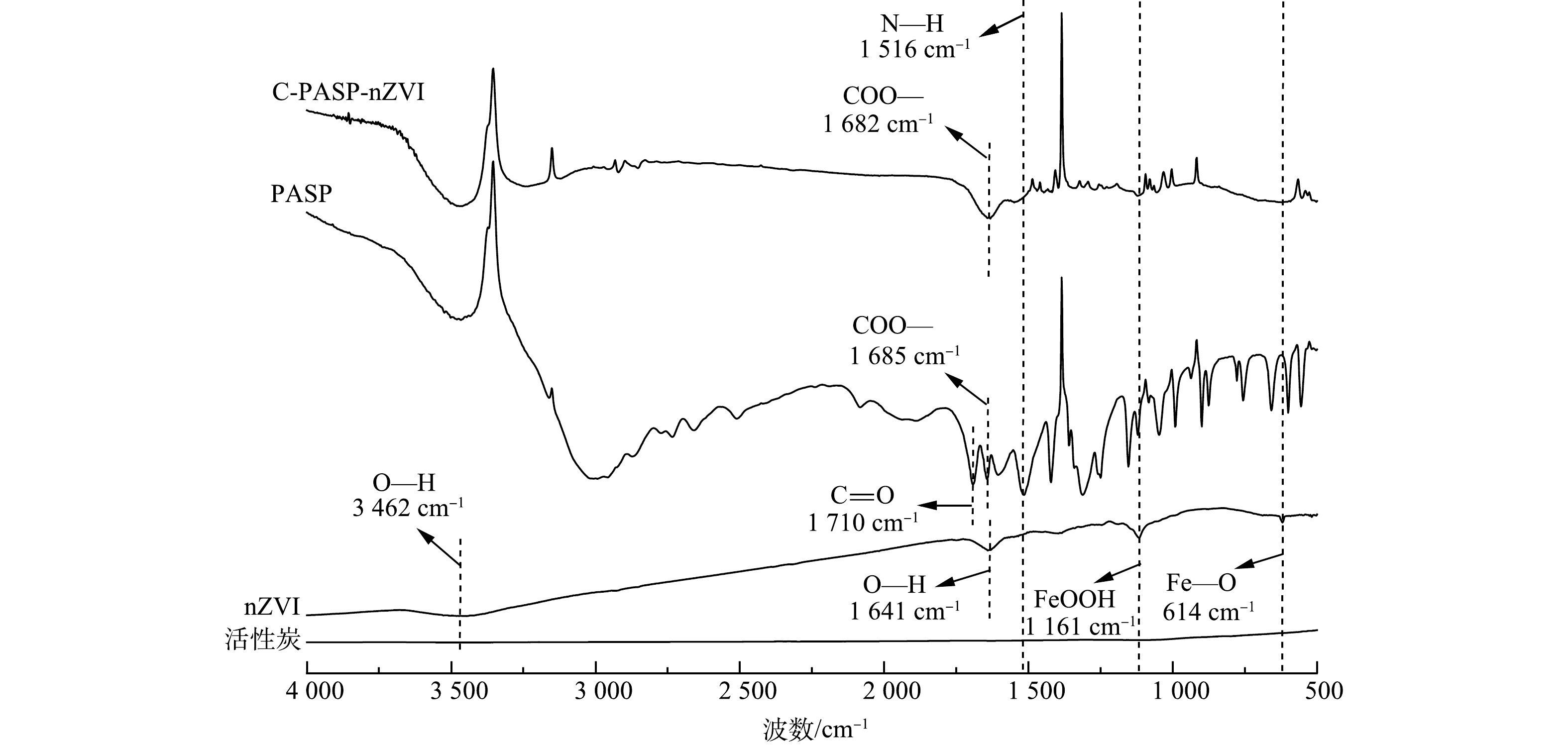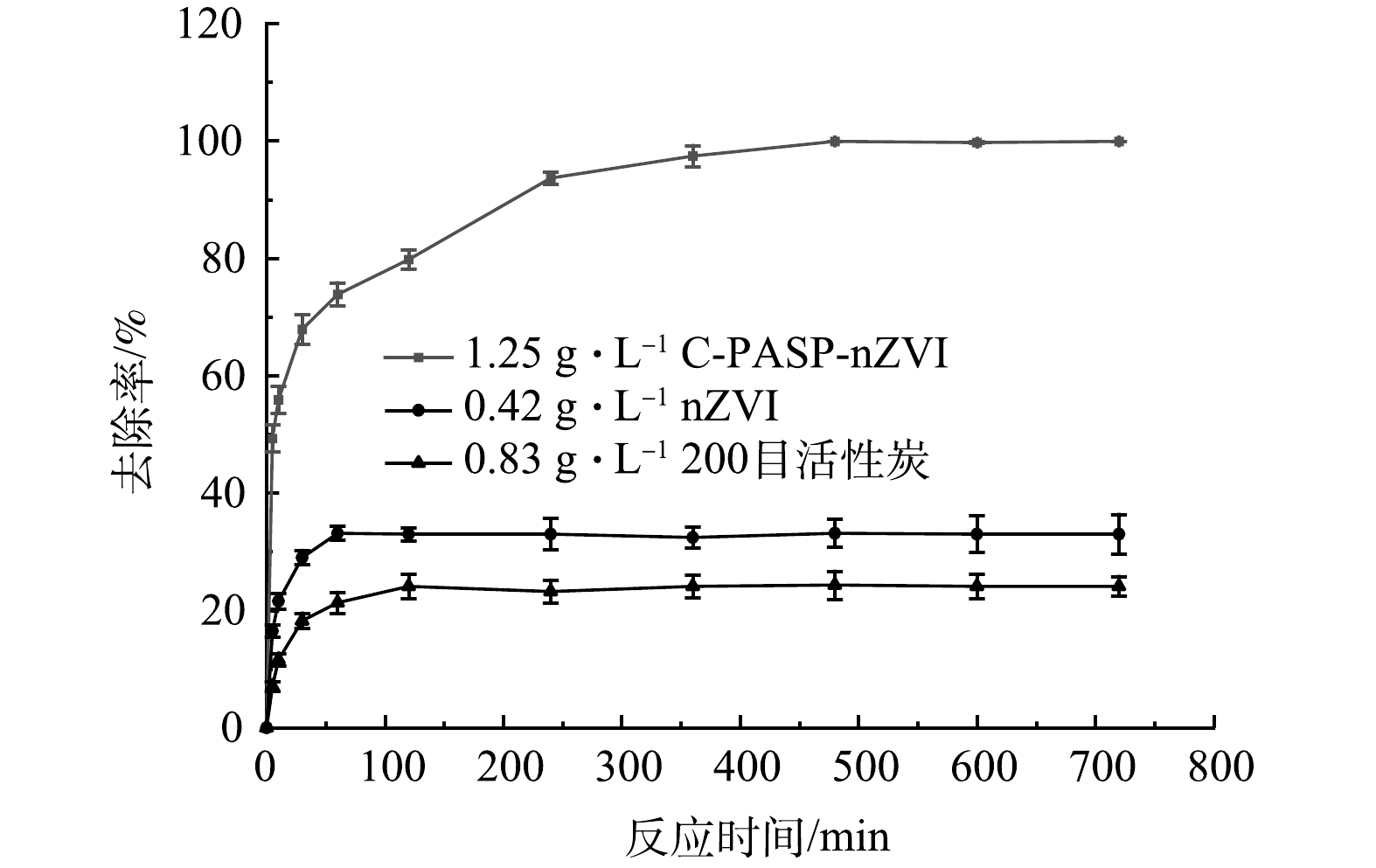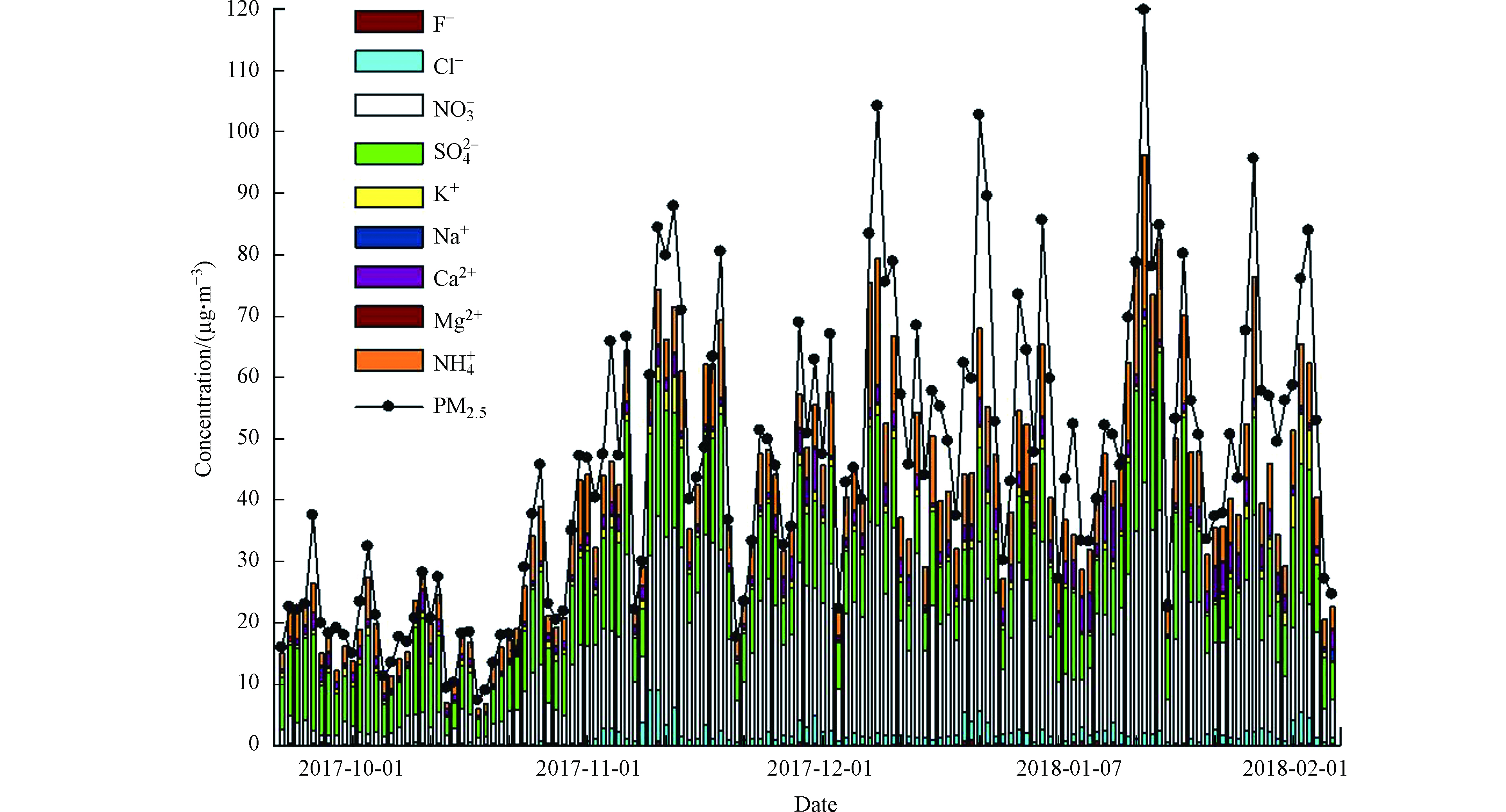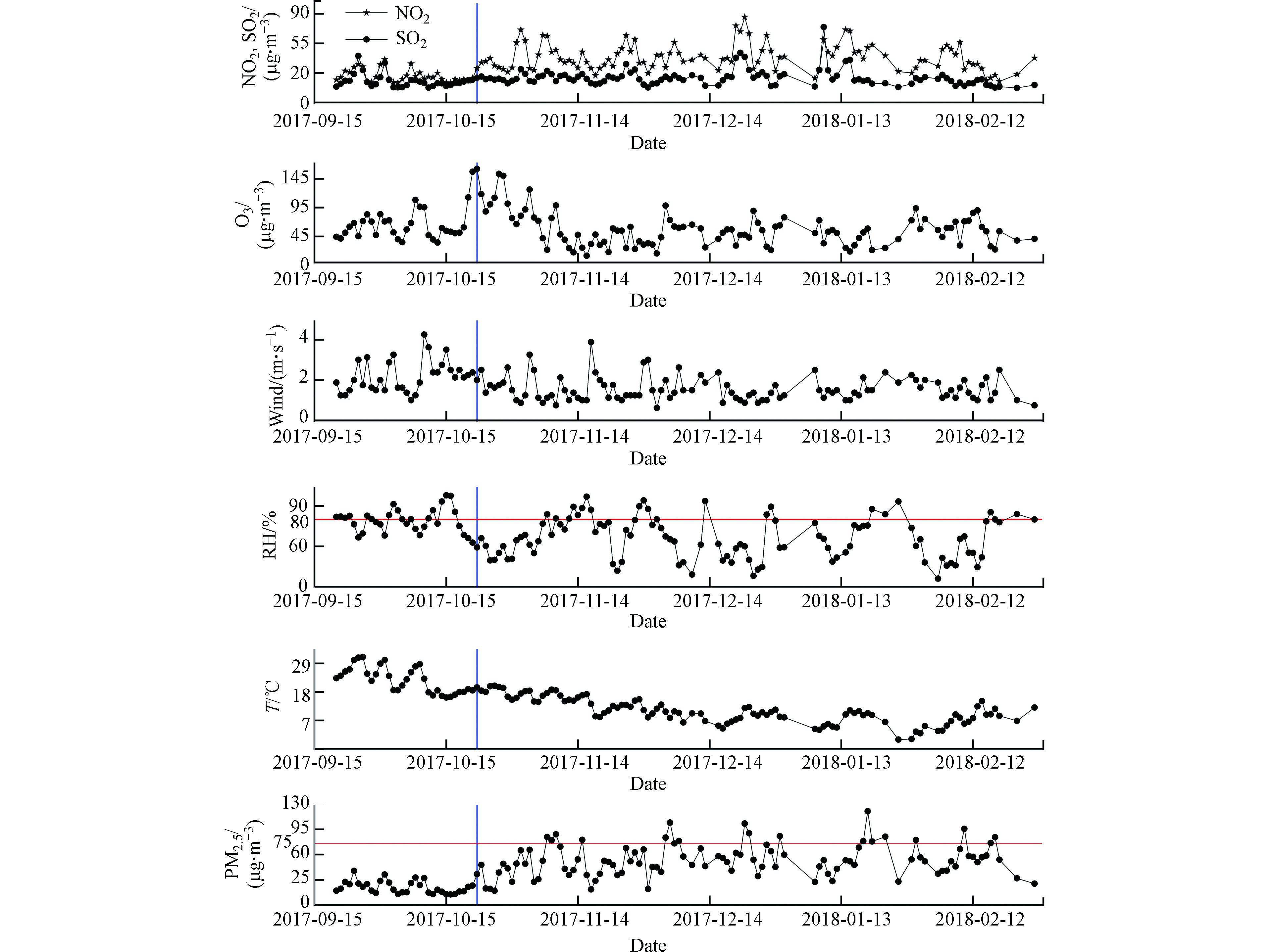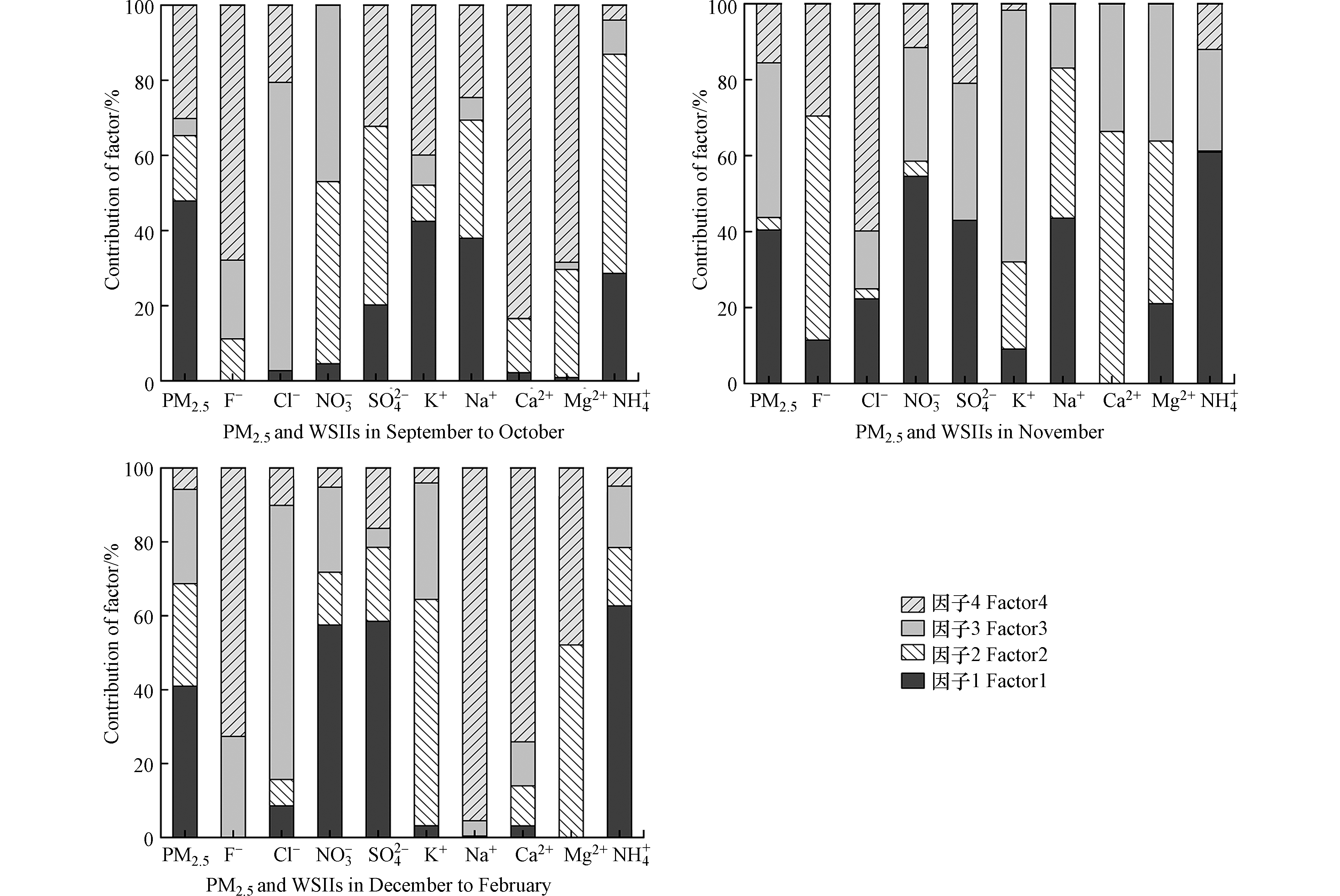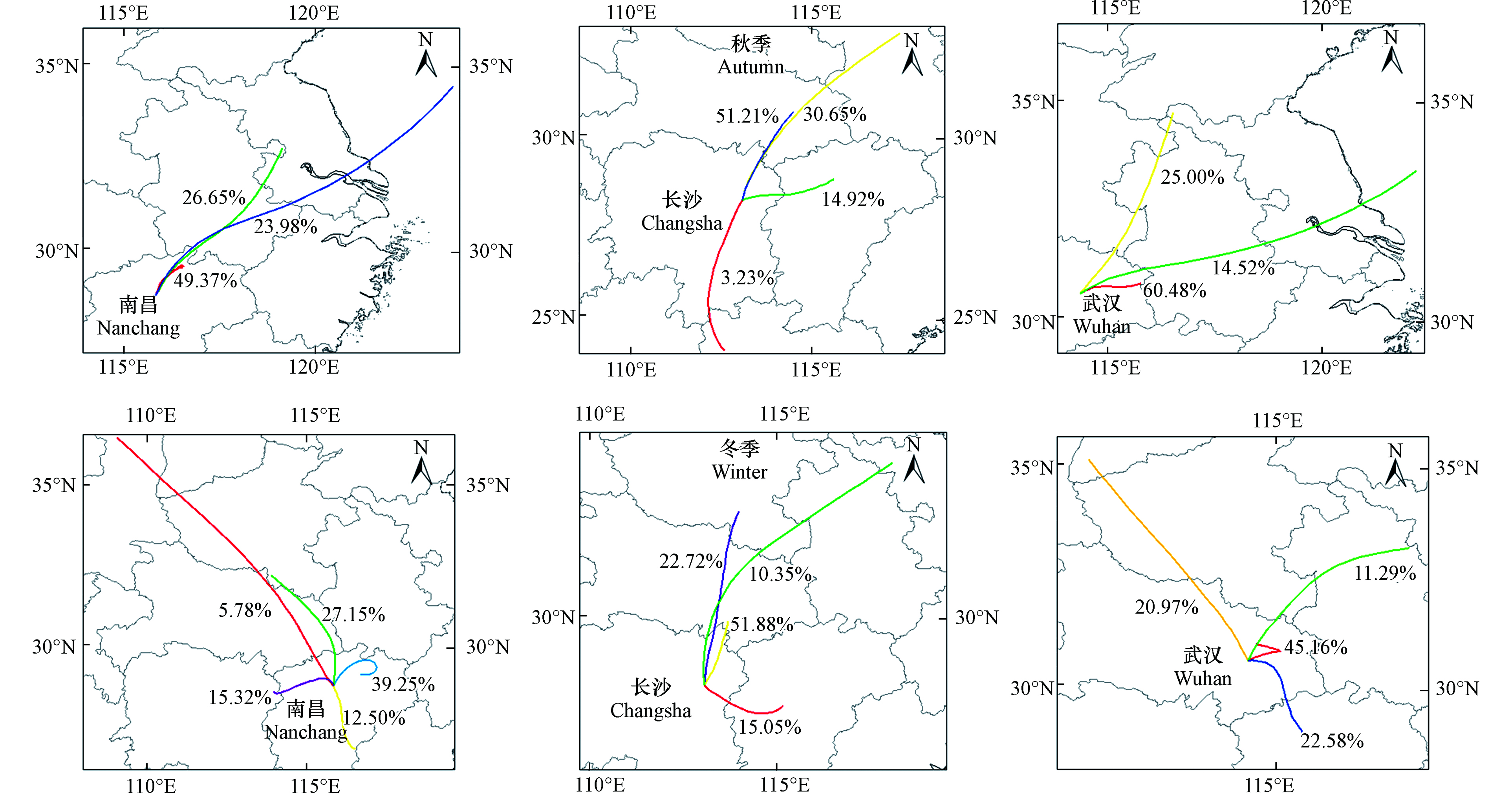-
随着我国经济快速发展和城镇化建设的持续推进,大气污染成为急需解决的环境污染问题[1-2]。自2013年“大气污染防治行动”以来,我国空气质量得到很大提升,但仍有灰霾事件频繁发生,大气细颗粒物PM2.5是造成灰霾事件形成的关键污染物,其中的硝酸盐浓度占比逐渐升高,尤其在灰霾天气占比可达11%—36%[3]。PM2.5沉降速度缓慢,影响大气能见度,且易携带有害物质被人体吸入,严重危害人体健康[4-5],PM2.5中以水溶性离子为主要成分,占比往往达60%以上,其中又以
SO2−4 、NO−3 和NH+4 (SNA)离子为主。SNA的形成包括均相和非均相反应,例如SO2−4 由大气中的SO2在TMI催化下与O2反应或经OH或HO2自由基氧化转变为SO3,这是气相均相反应,SO3与H2O反应形成H2SO4,并与NH3反应形成(NH4)2SO4或NH4HSO4颗粒,这是气-液相非均相反应。NO−3 是由NO2主要经过两大氧化途径形成:(1)NO2被OH氧化形成HNO3(白天途径);(2)N2O5水解反应形成HNO3(夜间途径)(这个夜间途径也包括NO3被HC有机质氧化反应,通常占比较少[6]),生成的HNO3与NH3或其他离子反应形成硝酸盐颗粒。这些反应过程不但受大气中SO2、NO2和NH3浓度的影响,也受地形、风向风速、气温、湿度等气象条件的影响[7],导致不同地区气溶胶形成的机制不同。作为灰霾形成的关键污染物,PM2.5的来源复杂,包括化石燃料燃烧、生物质燃烧和建筑扬尘等[8],区域特征明显并且季节性变化较强[9]。因此,分析PM2.5的水溶性无机离子组成特征及其排放源不但对制订相应的减排计划、降低排放的负面环境效应至关重要,而且对更好地理解全球大气传输也有重要意义。中国中部地区包括江西、湖南和湖北,两两相连,以南昌、长沙、武汉为省会城市,呈三角形态分布,地处长江中下游,水陆交通发达,城市人口密集,能源消耗、工业生产和机动车辆等都是重要经济支撑。中部地区属亚热带季风气候,秋季温暖,冬季寒冷。我国南北气候、工业分布等差别很大,空气污染研究多聚集在京津冀、长三角和珠三角城市,对华中城市系统研究相对较少。本研究以南昌市为主要采样点,通过持续6个月的秋冬季(2017.09—2018.02)的日采样,采用化学计量法、同位素方法、PMF溯源及气团后向轨迹分析等方法,分析南昌市秋、冬季大气PM2.5及其水溶性无机离子的化学特征及其来源,并在典型的秋季(10月)和冬季(1月)同步采集另两个中部省会城市(长沙和武汉)的PM2.5日样品,对比分析3个中心城市水溶性离子的化学组成特征及其来源,以期对中部城市大气污染的区域传输研究提供一定的理论支撑。
-
本研究于2017年9月至2018年2日在南昌市东华理工大学地学楼楼顶(28.72°N,115.83°E)采集大气PM2.5样品,采样高度距地面约18 m,采样点周边环境由居民区和交通道路组成。使用青岛崂山电子KC-1000采样器,流量1.05 m3·min−1,共收集PM2.5样品134个,采样时间为上午09:30至次日09:00,时长为23.5 h,样品采集后装进自封袋带回实验室密封低温避光保存。采样前石英滤膜于450℃高温灼烧4 h,以去除杂质。另外,长沙和武汉在2017年10月(秋季)和2018年1月(冬季)进行各为期二个月与南昌市同步日采样(图1),长沙采样点为湖南农业大学第11教学楼顶,武汉采样点为武汉大学工学部第9教学楼顶。空气质量数据(包括PM2.5、污染气体SO2、NO2、O3 和CO浓度)及气象数据(温度、相对湿度等)来自于附近的环境监测站。
-
在超净室内,将1/4张PM2.5样品滤膜置于50 mL聚四氟乙烯离心管内,加入50 mL去离子水定容,超声震荡30 min,离心10 min,静置10 min,之后用0.22 μm微孔滤膜过滤上清液,用于阴阳离子浓度和同位素值测定。
采用离子色谱法(Thermo Scientific™, USA)分析PM2.5中9种水溶性无机离子的质量浓度(F−、Cl−、
NO−3 、SO2−4 、K+、Na+、Ca2+、Mg2+、NH+4 ),检出限分别为3.80、5.10、21.60、11.50、1.77、0.001、0.09、2.47、1.21 μg∙L−1。NO−3 氧同位素(δ18O)的测定:根据测定的NO−3 浓度,取适量样品利用反硝化细菌法将硝态氮转化为N2O,Gas Bench II浓缩富集后,同位素比值质谱仪(IRMS,Delta V advantage)测定N2O的δ18O-N2O,采用USGS32、USGS34、USGS35为国际标准,标准偏差±0.8‰。 -
ISORROPIA-II是一种无机热力学平衡模型[10-11],是目前研究气溶胶pH中使用最多的模型,输入数据包括Na+、
SO2−4 、NH+4 、NO−3 、Cl−、Ca2+、K+、Mg2+、RH(相对湿度)和T(温度),模式有forward和reverse,forward模式中半挥发性组分需要输入气溶胶相和气相浓度的总和,reverse模式只需要输入气溶胶相浓度。气溶胶状态包括stable(稳态)和metastable(亚稳态),stable指在超饱和状态下,无机盐会沉淀,metastable指在超饱和状态下,无机盐不会沉淀。本研究气溶胶pH值采用forward模式和metastable气溶胶状态结合估算[12]。 -
SIAR是一个基于R统计软件的稳定同位素混合模型,根据理论计算的同位素分馏系数[13]和测定的
NO−3 的δ18O组成,可以甄别NO−3 生成路径[14],同位素值可以通过直接与分馏因子相加而得到修正。 -
PMF(Positive matrix factorization)模型是基于受体点的大量观测数据来估算污染源的组成和对环境浓度的贡献[15]。PMF 将指定数据的矩阵分解为因子分布和源贡献的两个子矩阵,使用最小二乘法使Q值达到最小化来解析污染源概况和相对贡献,在2—10个因子数范围内检验Q/Qexp以确定最佳因子数。PMF已被广泛用于来源解析[16],本研究运用美国环境保护局EPA PMF5.0进行PM2.5的源解析。
-
利用美国海洋与大气局(NOAA)空气资源实验室(ARL)开发的拉格朗日综合轨迹模式的HYSPLIT模型,结合全球数据同化系统(GDAS)的全球气象数据作为气象参数,采用Meteoinfo软件进行分析和作图 [17-18]。本研究将3个中部城市的10月和1月每日每小时到达采样点的气团(UTC时间)后推48 h计算,模拟的高度为500 m,分析3个城市气团的输送轨迹。
-
南昌市PM2.5平均质量浓度在9—10月(秋季)与11月(深秋)和12—2月(冬季)差别较大,分别为(22.5±9.1)μg∙m−3与(49.5±21.1)μg∙m−3、(57.6±20.9)μg∙m−3(图2),可见,秋季空气质量较清洁(<35 μg∙m−3),深秋到冬季逐渐变差。其中WSIIs在秋、冬季质量浓度也有显著差别,分别为(20.1±7.2)μg∙m−3和(47.2±16.2)μg∙m−3,WSIIs从高到低在秋冬季顺序也有不同,秋季为
SO2−4 >NO−3 >NH+4 >Ca2+>K+>Cl−>Na+>F−>Mg+,冬季为:NO−3 >SO2−4 >NH+4 >Ca2+>Cl−> K+ >Na+>F−>Mg+,可见秋冬季SO2−4 、NO−3 和NH+4 的3种离子都是WSIIs的主要组成离子。WSIIs秋、冬季在PM2.5中占比分别为89%和82%,表明WSIIs在PM2.5中的占比在清洁天(<35 μg∙m−3)大于在污染天(>35 μg∙m−3),这个情况即使在冬季相对清洁的天气和污染天比较也是如此,表明PM2.5从清洁天到污染天除无机离子浓度增加外,可能其他成分(如黑炭或有机物等)所占比例也增加。3种主要离子
NO−3 、SO2−4 和NH+4 (SNA)在秋季浓度分别为(5.1±3.1)μg∙m−3、(9.7±3.5)μg∙m−3和(3.6±1.8)μg∙m−3,分别占WSIIs的27.3%、45.6%和19.6%;而在深秋和冬季浓度分别为(20.5±7.8)μg∙m−3、(12.7±5.1)μg∙m−3和(7.8±3.3)μg∙m−3,分别占WSIIs的43.1%、26.9%和16.5%,从秋季到冬季,NO−3 、SO2−4 和NH+4 质量浓度分别增长到4倍、1.3倍和2.2倍。虽然在冬季SNA绝对浓度都增长了,但在WSIIs占比中NO−3 增长了16%,而SO2−4 和NH+4 分别下降了19%和3%,可见NO−3 是影响冬季PM2.5水平增长的重要驱动因素。由图3可见,在10月底,南昌市无论是空气质量(SO2、NO2、O3、PM2.5浓度)还是气象条件(相对湿度、温度、风速等)都出现了较明显的差别,秋季气温均值23.5 ℃,NO2浓度略高于SO2,O3均值71 μg∙m−3;而在冬季,NO2浓度却是秋季的2倍以上,气温下降明显(均值为9 ℃),SO2浓度略升高,湿度略降低(从75%至69%),O3下降较多(均值53 μg∙m−3)。不同季节气象条件的变化,可能是WSIIs在不同季节的来源或化学转化存在差异的关键因素。
-
南昌、长沙和武汉在秋冬季(10月和1月)的空气质量和WSIIs等浓度特征列于表1,秋季南昌的PM2.5、CO、SO2、NO2及WSIIs比长沙和武汉偏低,长沙最高;冬季长沙PM2.5最高(均值为88.5 μg∙m−3),但是长沙空气质量浓度和离子浓度却比武汉和南昌两城市略低,WSIIs占PM2.5比为45%,表明长沙PM2.5中含有更高比例的其他成分,长沙在秋冬季的高风速(>3 m·s−1)可能带来外部气团对长沙的大气污染。南昌在秋冬季SNA占PM2.5和WSIIs比例都高于其他两个城市,南昌O3浓度无论秋冬季在三城市中最高,NOR和SOR也比两城市略高,这可能是南昌SNA转化水平高于其他两个城市的主要原因。
中部城市PM2.5及WSIIs浓度在秋季和冬季差别较大,尤其是
NO−3 、NH+4 、Cl−和NO2浓度在冬季显著高于秋季,温度和O3显著降低(P<0.05),而SO2−4 >、SO2浓度和SOR、NOR虽然冬季有上升但与秋季相比无显著差别。虽然中部城市秋季SO2−4 浓度高于NO−3 浓度,而冬季NO−3 浓度大幅高于SO2−4 浓度,但是无论秋冬季NO−3/SO2−4 (物质的量比)都大于1,表明机动车尾气大于燃煤对NO−3 和SO2−4 的贡献。CO可看作燃煤的初级排放,与SO2−4 进行相关性分析得出秋季三个城市R2分别为0.63、0.41、0.22,冬季更低R2为0.28、0.12、0.04,表明SO2−4 主要来自于机动车尾气排放的二次产物,不同于北方城市秋冬季NO−3/SO2−4 (物质的量比)<1,比如济南、太原[19-20]主要是燃煤贡献为主。中部城市Cl−浓度在冬季大幅升高与工业排放有关。机动车尾气和工业是主要排放源,是中部城市PM2.5冬季大幅升高的主要原因。洞庭湖位于长沙和武汉的中间位置,Xie等 [21]将此作为中部城市的背景点,研究表明全年平均PM2.5为43.4 μg∙m−3,SNA为28.0 μg∙m−3,高于其他背景点和一些城市的气溶胶浓度,认为受中部区域气团影响,工业和二次NO−3 >和SO2−4 是PM2.5的主要来源,这与本研究得出的结论一致。 -
水溶性离子的质量浓度C(μg∙m−3)转换为电荷浓度Ce(µmol∙m−3)的计量关系为:
式中C、Ce、M和n分别为离子的质量浓度、电荷浓度、分子量和离子的电荷数。
南昌市样品中PM2.5总阴阳离子电荷浓度比值接近1∶1,R2为0.80 (图4a).使用方程
[NH+4] 过量= ([NH+4 ]/[SO2−4 ]−1.5)×[SO2−4 ]表示NH+4 在与SO2−4 结合中是否过量(电荷浓度μeq·m−1[22]),采样期间秋季大部分数据中[NH+4 ]过量<0(图4b),表明NH+4 相对于SO2−4 亏损,主要以(NH4)2SO4和NH4HSO4形式存在;而冬季 [NH+4 ]过量>0,表明NH+4 过量,能将SO2−4 完全中和,过量的NH+4 与NO−3 正相关,P<0.001(图4b),主要以(NH4)2SO4和NH4NO3的形式存在,NO−3 与过量NH+4 的R2约为0.37,表明NO−3 与NH+4 结合外,还可能与其他离子如K+、Na+、Ca2+和Mg2+结合成硝酸盐。南昌市的氨富余情况不比昆明[23]、西安[24]、郑州[25]及华北平原[26]等城市严重,南昌冬季提高空气质量需要同时控制NOx和NH3排放。pH值是气溶胶的重要性质之一,直接受气溶胶的气-粒分配及其化学组分影响[22]。pH主要取决于
NH+4 、NO−3 和SO2−4 (SNA)离子组成丰度,其中SO2−4 和NO−3 的增加会增加酸度(pH值降低),NH+4 的增加会中和酸度,研究表明,当PM2.5中NO−3/SO2−4 (物质的量比)升高时,其中的NH4NO3会逐渐富集,pH值升高[27]。南昌PM2.5的pH值从秋季2.8升高到冬季4.1(图5),表明冬季富余的NH+4 (图4b)起重要的中和作用[28]。NO−3/SO2−4 >(物质的量比)和NH+4/SO2−4 (物质的量比)在冬季也明显高于秋季,表明NO−3 和NH+4 在冬季增长率都高于SO2−4 (图5)。如前面2.1.1节所述,秋季到冬季,虽然SNA质量浓度绝对值都增长了,但在WSIIs占比中NO−3 增长了16%,而SO2−4 和NH+4 分别下降了19%和3%,下降程度更大的SO2−4 使得富余的NH+4 增加了与NO−3 结合的机会(NH+4 优先与SO2−4 结合[29]),使得冬季NH4NO3浓度增加,即富余的NH+4 促进NO−3 的形成,两者具有相互促进作用,由此形成的NH4NO3颗粒使冬季PM2.5浓度升高,容易成为灰霾天气。从转化途径看,SNA是PM2.5主要水溶性离子,是由SO2、NO2和NH3的二次转化产物。在大气中
NO−3 的生成主要由NO2经过两个氧化路径,即白天OH路径(NO2+OH+M→HNO3+M)和夜间N2O5路径(NO2+O3→NO3+O2,NO2+NO3→N2O5,N2O5+H2O+surface→2HNO3),这两个路径不仅受NO2浓度的影响,也受温度、光照、O3、OH等因素的影响[1,13]。NO−3 的氧同位素(δ18O)主要受氧化过程的影响,可以用来表征NO−3 生成路径[30]。在本研究中,南昌秋、冬季测定的NO−3 的δ18O存在较大差异:10月δ18O-NO−3 均值为+72.2‰±5.5‰,范围+59.7‰—+83.9‰;11—1月δ18O-NO−3 均值为+86.1‰±5.1‰,范围+71.2‰—+97.7‰。将测定的δ18O-NO−3 ,及以OH和N2O5为两个主要氧化路径输入贝叶斯同位素混合模型,结果表明,秋季NO−3 的OH氧化路径占54%±10%,N2O5路径占46%±8%,而深秋和冬季主要是N2O5水解路径为主(75%±7%)。秋季阳光明媚,温度适宜,OH浓度较高,有利于NO2被OH氧化,形成的硝酸容易以气态形式存在;冬季低温有利于颗粒物表面吸湿,大幅提高N2O5水解表面积,有利于硝酸以液态存在[31]。另外,从转化率来看,南昌氮氧化率(NOR =
NO−3 / (NO−3 + NO2),物质的量浓度)冬季(0.29)比秋季明显上升(0.16),NO−3 (21.7 μg∙m−3)也明显高于秋季(5.3 μg∙m−3)(图6a)。O3和相对湿度对NO−3 影响明显P<0.01,温度在秋、冬季变化大,对NO−3 有明显的负相关性(R2=−0.46,P<0.01),表明NO−3 >浓度不但取决于NO2浓度和NOR,也受O3、RH和温度等条件的重要影响。硫氧化率(SOR=SO2−4 / (SO2−4 +SO2))在秋冬季变化很小(均值0.41—0.43),冬季SO2浓度略有上升(图6)。O3、温度和相对湿度在秋冬季对SO2−4 和SOR影响不明显(P>0.05,双尾检查),这不同于其他研究认为在北方O3和相对湿度对SO2−4 >和SOR冬季和夏季影响较大 [23,32]。以上可见,
NO−3 和SO2−4 作为NO2和SO2的二次转化产物,冬季NO−3 浓度明显升高取决于NO2和NOR的明显提高;而SO2和SOR在秋冬季变化较小,SO2−4 浓度的变化也在秋冬季变化不大。另外,气象因素对NO−3 影响较大,而对SO2−4 的影响较小,这些不同归因于NO−3 和SO2−4 的排放源强、形成路径及受气象条件的影响不同。NH+4 浓度水平的提高也促进NO−3 的形成[33],南昌PM2.5中NH+4 与NO−3 和SO2−4 都有强相关性(R2=0.85, 0.71, P<0.01);NH+4 与NOR和SOR也有较好的相关性(R2=0.69, 0.34, P<0.01),表明大气中的NH3浓度也是影响NO−3 和SO2−4 形成的主要因素。反之,冬季NO−3 和SO2−4 浓度的增长也促进了NH3的液相转化为NH+4 [29]。 -
基于PMF模型,南昌PM2.5的潜在来源可以用主要4个因子来判断和定量,分别为二次源、工业、生物质燃烧、扬尘。这些排放源在秋冬季对PM2.5贡献率存在差异,是与不同季节WSIIs各离子浓度的变化相一致的(图1,图7)。
9—10月,因子1代表生物质燃烧源,主要以27.1%的K+、22.1%的Na+、26.9%的
NH+4 为主要特征;因子2代表二次源,主要来自于燃煤和机动车尾气及工业等排放,是以46.9%的NO−3 、41.8%的SO2−4 、54.9%的NH+4 为主要特征;因子3代表工业源,是68.0%的Cl−、45.4%的NO−3 为主要特征;因子4代表地壳和建筑扬尘,是以78.8%的Ca2+、58.7%的Mg2+、59.3%的F−为主要特征。4个因子对PM2.5的贡献率分别为17.4%、47.9%、4.6%、30.1%。二次源和扬尘是最大贡献源,共占78%。11月,因子1是二次源,以49.5%的
NO−3 、31.3%的SO2−4 、46.6%的NH+4 为特征;因子2是扬尘,以61.6%的Ca2+、31.5%的Mg2+为特征;因子3是生物质燃烧源,以60.7%的K+、24.8%的Mg2+为特征;因子4是工业源,以56.7%的Cl−为主要特征。4个因子分别贡献PM2.5的40.7%、8.5%、19.6%、31.2%,二次源及工业源是最大贡献源,共贡献了PM2.5的71.9%。12—2月,因子1是二次源,以57.5%的
NO−3 、58.5%的SO2−4 、62.7%的NH+4 为主要特征;因子2是生物质燃烧,以61.3%的K+、52.1%的Mg2+为特征;因子3是工业源,以74.2%的Cl−为主要特征;因子4是扬尘,以72.7%的F−、74.1%的Ca2+、95.4%的Na+、47.8%的Mg2+为特征。4个因子分别贡献PM2.5的41.0%、25.5%、27.7%、5.8%,二次源是PM2.5的最大贡献源,其次是工业,两者共贡献68.7%。同样,以PMF方法分析长沙和武汉10月秋季和1月冬季的PM2.5贡献源,主要4个因子是:二次源,工业,生物质燃烧及扬尘,长沙10月的贡献率分别是52.1%、6.9%、16.2%、24.8%,二次源及扬尘共贡献了76.9%的PM2.5;武汉10月的贡献率分别是44.0%、29.9%、11.9%、14.2%,以二次源及工业为主,共贡献73.9%的PM2.5。长沙1月贡献率分别是56.8%、26.3%、0.7%、16.2%,二次源及工业共贡献84.1%的PM2.5;武汉1月贡献率分别是45.8%、34.8%、4.1%、15.3%,二次源及扬尘共贡献80.6%的PM2.5。可见,长沙和武汉秋冬季以二次源及工业是主要贡献源,贡献率在59%—83%之间,长沙秋季扬尘贡献率为24.8%,因为长沙秋季风速较高(3.5 m·s−1)。
3个中部城市秋冬季
NO−3/SO2−4 >1(物质的量比),表明机动车尾气大于燃煤对二次源NO−3 和SO2−4 的贡献[29]。 -
南昌PM2.5中Ca2+是第二大阳离子,在总WSIIs中排第四位,Mg2+是WSIIs中含量最少的离子。研究表明,Mg2+/Ca2+小于0.09,则认为Ca2+来自于土壤尘,0.12和0.17则认为分别来源于海盐和沙漠[34],高于这些值则认为来源于工业和燃煤。本研究中的Mg2+/Ca2+平均值为0.07(范围0.04—0.14,不包含在2月15—18号范围为0.42—1.25,这个时期是我国传统的春节燃放烟花爆竹,Mg2+和K+含量最高),Mg2+和Ca2+有强相关性(R2=0.73,P<0.01),表明南昌Ca2+和Mg2+主要来源于地壳和城市建设的扬尘。
Cl−和K+有多种来源,如生物质燃烧、煤燃烧和海盐等,一般认为低Cl−/K+,以及Cl−和K+有强相关性,则认为K+来源于生物质燃烧[35]。本研究中Cl−/K+在9—10月比值平均为0.3,Cl−和K+相关性R2=0.52,而在11—2月比值均值为1.6,R2=0.45,表明K+部分来源于生物质燃烧。海盐中Cl−/Na+约为1.8[35-36],本研究中Cl−/Na+大于1.8,Cl−和Na+无相关性(P>0.5),海盐贡献可以忽略,Cl−主要来源于工业[37]。
-
3个中部城市秋冬季(10月,1月)污染物的气团影响路径见图8。秋季,南昌污染物主要来自于本地源,近50%气团受江西东部影响;另50%气团受我国中东部地区影响,途经黄海、江苏、上海,最后经过安徽到达南昌,受海上气流稀释影响,气团运动携带污染物相对较少,南昌秋季空气质量较好。长沙污染物主要受湖北影响(气团占51.4%);另有气团于山东途径河南,及来自于安徽的气团,这两路气团都经过湖北输入长沙(24.3%);少数受江西影响(气团占19.2%);极少数气团受广东省影响(3.1%),长沙秋季风速高,污染物浓度较高,与上述来源于发达工业城市的气团影响有关。
武汉秋季污染物大部分来源于湖北鄂州(气团占60.5%),鄂州矿藏资源丰富,工业发达,气团运动携带沿途污染物输送到武汉,属于本地源;其次是来自安徽北部(25.0%),少数气团来源于中东部区域及黄海,途经江苏和安徽由东向西输送到武汉。以上分析可见,长沙秋季污染物浓度最高,主要受外部输入影响,南昌秋季空气质量相对清洁,武汉秋季污染物主要在于本地源排放。
冬季,南昌污染物主要在于本地源,气团有51.8%受江西本地的东部和南部影响,其次受来自于陕西,途径山西、河南,再经过湖北到达南昌的气团影响(32.9%),湖北、陕西和山西工业发达,工业污染源较多,河南人口密集,人为源影响较大,另外北方冬季还有燃煤取暖污染;另有也受湖南影响(气团占15.3%)。长沙冬季污染物主要来源于湖南本地(气团占51.9%);另受安徽、河南,再经过湖北到达湖南进入长沙的气团影响较大(气团33.1%),少数受江西气团影响(15.1%)。武汉冬季污染物主要来自于武汉和咸宁,属于本地源,该气团(45.2%)路径短,风速小,污染物积聚;其次受江西北部气团影响(22.6%)和起源于山西,途经河南,由北向南从湖北输送到武汉的气团影响(21.0%);少数受于安徽省中部,经河南省南部输送到武汉的气团影响(11.3%)。由以上分析可见,中部城市冬季污染物主要来源于本地,但是西北方向的气团对中部城市污染物的影响也较大,武汉方向的气团对长沙和南昌的污染影响明显。
综上,中部城市秋冬季污染物浓度长沙>武汉>南昌,主要来自于本地源(本地气团影响占45%—60%),其次受区域传输气团影响(25%—50%,长沙秋季为70%),另外山西、河南、安徽方向的携带污染物的气团影响不可忽视,中部区域气团环流可能是中部城市污染物浓度共同增长的主要原因。我国北方城市以本地源污染占更大比例,比如北京本地源占64%—72% [16]。
-
南昌市在2017—2018年秋冬季PM2.5和化学组成有较大差异,SNA占WSIIs比例在9—10月分别为27.3%、45.6%和19.6%,而在11—2月分别为43.1%、26.9%和16.5%,
NO−3 含量在冬季大幅升高。中部城市秋季SO2−4 浓度高于NO−3 浓度,而冬季NO−3 浓度大幅高于SO2−4 浓度,与之结合的NH+4 浓度也随之升高,这些变化与秋冬季不同季节二次颗粒物的形成路径及污染物的积累不同密切相关,也与气团的来源密切相关。中部城市秋冬季的大气污染以二次源污染为主,其次是工业污染,又以本地源占45%—60%为主,区域传输为25%—50%,气团在中部区域环流是中部城市大气共同污染的重要因素,另外西北地区的空气污染对中部城市也有重要贡献,尤其在冬季。中部区域冬季NH4NO3颗粒的大幅增长是颗粒物污染的关键因素,主要来自于二次污染源,冬季在控制NO2排放的同时,需要控制NH3排放。
中部城市秋冬季PM2.5水溶性离子的化学特征及来源
Chemical characteristics and sources of PM2.5 and water-soluble ions in autumn and winter in central China
-
摘要: PM2.5是影响空气质量、引发灰霾污染发生的关键污染物。本研究以南昌为主要采样对象,分析了南昌市2017—1018年秋、冬季PM2.5和水溶性无机离子(WSIIs)的化学组成及其来源,并同时期采样和对比分析了中部城市(武汉和长沙)秋冬季(10月和1月)PM2.5及WSIIs化学特征及其来源。结果表明,南昌市采样期间WSIIs平均占PM2.5质量浓度的60%以上,PM2.5和WSIIs组成在秋、冬季差别明显,在秋季,PM2.5为(22.5±9.1)μg∙m−3,空气质量较清洁,以
SO2−4 为WSIIs中最高含量的组成离子;NO−3 的氧同位素(δ18O)值为+72.2‰±5.5‰,贝叶斯同位素混合模型表明NO−3 以OH氧化为主要生成路径(占比54%,N2O5水解路径占比46%);以SO2−4 和过量的NH+4 作比较表明秋季一般亏损NH+4 。而在冬季,PM2.5和WSIIs浓度水平比秋季有较大提高,分别为(57.6±20.9)μg∙m−3和(47.2±16.2)μg∙m−3,冬季以NO−3 为WSIIs的最高含量组成离子,δ18O-NO−3 值明显提高为+86.1%±5.1‰,NO−3 以N2O5水解为主要生成路径(占比为75%);SO2−4 和过量的NH+4 作比较表明富NH+4 ,冬季NO−3 的快速增长和NH+4 富余是PM2.5浓度增加的重要驱动因素。基于PMF和后向轨迹分析,气团在中部城市的环流是三大城市PM2.5和SNA共同污染的重要因素,说明中部城市的大气污染区域效应明显,尤其是在冬季。南昌秋季PM2.5主要由二次源和扬尘贡献(共占78%),冬季主要由二次源和工业贡献(共占69%)。武汉和长沙PM2.5秋冬季都以二次源和工业贡献为主。Abstract: PM2.5 is the main pollutant of air quality, and haze weather often occurs in autumn and winter. Water-soluble ions are the main components accounting for more than 60% of PM2.5. In this study, the chemical characteristics and sources of PM2.5 and water-soluble ions (WSIIs) in autumn and winter during 2017—2018 were compared and analyzed using a variety of chemical and statistical methods during Nanchang, Wuhan and Changsha cities. The results showed that the composition of PM2.5 and WSIIs in Nanchang was significantly different in autumn and winter. The air was cleaner in autumn, withSO2−4 as the primary ion of WSIIs, and the mean value of δ18O-NO−3 was +72.2‰±5.5‰. Based on bayesian isotope mixing model, the main formation path ofNO−3 was OH oxidation accounting for 54%, and comparedSO2−4 and excessNH+4 ,NH+4 was poor in autumn. In winter, PM2.5 and WSIIs were (57.6±20.9) μg∙m−3 and (47.2±16.2) μg∙m−3,respectively.NO−3 was the primary ion of WSIIs, and the mean value of δ18O-NO−3 was +86.1‰±5.1‰.NO−3 was mainly generated by the hydrolysis of N2O5, which accounted for 75%, andNH+4 was excess. The rapid increase ofNO−3 and excessNH+4 are the driving factors for the increase of PM2.5 concentration in winter. The concentrations ofSO2−4 in autumn and winter are mainly controlled by SO2 and SOR, while the concentrations ofNO−3 are not only controlled by NO2, NOR and formation pathway, but also influenced by temperature. Based on PMF and backward trajectory analysis, the circulation of air mass in the central cities is an important factor for the co-pollution of PM2.5 and SNA in the three cities, which also indicates that the regional effect of air pollution in the central cities is obvious, especially in winter. In autumn, the PM2.5 in Nanchang was mainly contributed by biomass combustion and dust (78%), and in winter, it was mainly contributed by industrial and vehicle exhaust (69%).In Wuhan and Changsha, the main contribution of PM2.5 in autumn and winter was from industrial and vehicle exhaust.-
Key words:
- water-soluble ions /
- source apportionment /
- oxygen isotope /
- PMF /
- backward trajectory
-
铬(Cr)在金属表面处理、电镀、制革等领域有着广泛运用,在环境中主要以+6、+3价态形式存在。相比于Cr(Ⅲ),Cr(Ⅵ)更具危险性,对皮肤和呼吸道有强烈刺激作用,造成细胞毒性的同时还可诱发肝癌和肺癌[1]。以HCrO4−、CrO42-、Cr2O72- 3种形式存在的Cr(Ⅵ)均具有较高的溶解度和较强的迁移能力,容易在人体富集[2]。由于Cr(Ⅵ)具有极强的环境危害,相关污染事故频发,美国环保署将其列为优先污染物,我国将其列入5种重点重金属污染物名单。我国黄土高原和三门峡盆地的地下水中Cr(Ⅵ)浓度是GB/T 14848-2017《地下水质量标准》Ⅲ类标准的3.84~7.30倍[3-4],而湖南某污染场地地下水Cr(Ⅵ)的最高浓度可达Ⅲ类标准的2 180倍[5],此外,白云湖、东山湖、宿鸭湖等地表水也发现了不同程度的Cr(Ⅵ)污染,污染水平与当地工业发展相关,存在严重的生态风险[6]。因此,有必要研发安全、高效去除水体中Cr(Ⅵ)的方法。
纳米零价铁(nanoscale zero-valent iron, nZVI)比表面积大,其反应活性是普通微米或毫米级铁粉的数十倍甚至上百倍[7],可作为还原剂将Cr(Ⅵ)转化为毒性低、易沉淀、迁移能力差的Cr(Ⅲ),再通过控制pH即可将Cr(Ⅲ)从水中脱除[8]。但nZVI的缺点是易氧化或钝化、易团聚、电子选择性差,严重限制了在实践中的应用,因此,近年来关于nZVI的研究集中在使用改性手段克服上述缺陷,提高nZVI的修复性能[9]。由于活性炭具有丰富的孔隙结构和较大的比表面积,可为nZVI提供大量附着位点,因此,可减小nZVI颗粒间团聚趋势。此外,活性炭本身具有良好的吸附性能,也可通过吸附作用去除Cr(Ⅵ)[10]。聚天冬氨酸(polyaspartic acid, PASP)是一种绿色高分子材料,缓释性能良好,可通过静电排斥和空间位阻的双重作用,进一步降低nZVI粒径。作为缓释层,PASP一方面可起到有效的保护作用,提升材料抗氧化性能,另一方面可提高nZVI的电子选择性,提升使用性能[11]。
本研究使用PASP作为缓释剂,活性炭为载体,制备了缓释型nZVI-C复合材料。通过一系列表征、正交和吸附实验,明确了复合材料最佳制备条件,证实了复合材料对水中Cr(Ⅵ)具有优秀的去除效果,可为废水和天然水体中的Cr(Ⅵ)污染修复提供参考。
1. 材料与方法
1.1 实验试剂与仪器
实验所需试剂主要包括:七水合硫酸亚铁(FeSO4·7H2O)、无水乙醇(CH3CH2OH)、聚乙二醇(HO(CH2CH2O)nH)、硼氢化钾(KBH4)、重铬酸钾(K2Cr2O7)、氢氧化钠(NaOH)、硫酸(H2SO4)、盐酸(HCl)均为分析纯;PASP((C4H7NO4)x)为优级纯;二苯碳酰二肼(C13H14N4O)为色谱纯。高纯氮气(N2,99.999%)。本研究使用的黑色颗粒状活性炭购自天津科密欧试剂厂,纯度为定制分析纯。
实验所需仪器主要包括:X射线衍射仪(SmartLab(9),日本理学株式会社);扫描电子显微镜(SUPRATM55,德国蔡司股份有限公司);傅里叶变换红外光谱仪(MTN-
5800 ,日本理学株式会社);X射线光电子能谱(ESCALAB 250XI,美国赛默飞世尔科技有限公司);孔径比表面积分析仪(SSA-4300 ,北京众力挽生物科技有限公司)。1.2 材料制备方法
nZVI制备:将2.78 g的FeSO4·7H2O溶于20 mL水,同80 mL乙醇和3 g聚乙二醇一起加入三口烧瓶中,搅拌转速为700 r·min−1。在合成过程中持续通入氮气以保持无氧环境,通气20 min后将100 mL的pH=8,浓度为0.04 mol·L−1的KBH4溶液从恒压漏斗中滴入三口烧瓶,滴速控制为2滴·s−1。滴加完毕后继续搅拌50 min,反应机理如式(1)所示。
stringUtils.convertMath(!{formula.content}) (1) 复合材料制备:与制备nZVI的方法类似,在制备过程中使用PASP的乙醇溶液代替聚乙二醇,即在80 mL的乙醇中预先溶解0.5 g的PASP,并同活性炭加入三口烧瓶中。
1.3 最佳制备条件筛选
通过设计正交实验,研究4个因素(碳粒径、铁碳比、醇水体积比、PASP浓度)对nZVI去除Cr(Ⅵ)性能的影响,并通过极差和方差分析得出最佳制备条件和主要影响因素。每个因素设置3个水平,碳粒径设置60、100和200目;铁碳比设置2∶1、1∶2和1∶4;PASP质量百分比设置0.01%、0.1%和0.5%;醇水体积比设置4∶1、1∶1和3∶7。其中,醇与水体积比的设置参考了预实验结果,选取了醇水体积比为1:1,以及大于或小于1∶1时的最佳比例,探究3种比例下材料制备效果的差异。在不设空列时,可选取L9(34)正交表,如表1所示。选取对100 mg·L−1的Cr(Ⅵ)溶液的去除率作为评价标准,该浓度为电镀废水中的Cr(Ⅵ)相关浓度[12]。将9种不同条件下制得的复合材料加入含Cr(Ⅵ)溶液的离心管,溶液体积为40 mL,C-PASP-nZVI投加量为1.25 g·L−1,pH=2,放置在25 ℃的恒温振荡器中以220 r·min−1振荡24 h后取样过滤。
表 1 正交实验表Table 1. Orthogonal experimental table实验号 碳粒径/目 铁碳比 PASP质量百分比/% 醇水体积比 1 60 2:1 0.01 4:1 2 60 1:2 0.10 1:1 3 60 1:4 0.50 3:7 4 100 2:1 0.10 3:7 5 100 1:2 0.50 4:1 6 100 1:4 0.01 1:1 7 200 2:1 0.50 1:1 8 200 1:2 0.01 3:7 9 200 1:4 0.10 4:1 1.4 材料表征
采用X射线衍射仪(XRD)分析晶体结构,将图像经MDI Jade 6软件平滑处理;扫描电子显微镜(SEM)用于观测材料表面形貌;傅里叶变换红外光谱仪(FTIR)用于分析材料表面物质结构以及PASP稳定nZVI颗粒机制;使用X射线光电子能谱(XPS)对材料表面元素价态进行分析,使用Avantage软件进行分峰拟合;孔径比表面积分析仪(BET)用于分析不同材料的比表面积。
1.5 材料性能测试及影响因素分析
本实验中Cr(Ⅵ)的质量浓度均使用二苯炭酰二肼分光光度法,酸性条件下使用紫外可见分光光度计(732,中国)在540 nm波长下测定。对比C-PASP-nZVI与nZVI、活性炭去除Cr(Ⅵ)的效果时,分别向含有Cr(Ⅵ)溶液的离心管中加入一定量的C-PASP-nZVI、nZVI、活性炭,其中C-PASP-nZVI投加量为1.25 g·L−1,nZVI、活性炭的投加量依正交实验结果中的最佳铁碳比而定。溶液体积不变,pH=2,Cr(Ⅵ)质量浓度设置为150 mg·L−1,放置在25 ℃恒温振荡器中以220 r·min−1振荡。分别在5、10、30、60、120、240、360、480、600、720 min时用注射器过滤取样。
C-PASP-nZVI投加量、污染物质量浓度和初始pH可能影响对Cr(Ⅵ)的去除效果。在探究C-PASP-nZVI投加量对去除Cr(Ⅵ)的影响时,分别取0.01、0.03、0.05 g材料加入含Cr(Ⅵ)溶液离心管,溶液体积为40 mL,Cr(Ⅵ)质量浓度为150 mg·L−1,pH=2,放置在25 ℃恒温振荡器中以220 r·min−1振荡。分别在5、10、30、60、120、240、360、480、600、720 min时用注射器过滤取样。
探究污染物浓度对去除Cr(Ⅵ)的影响时,溶液体积不变,Cr(Ⅵ)质量浓度分别设置为100、150、200 mg·L−1,C-PASP-nZVI投加量为1.25 g·L−1,pH=2,在相同条件下振荡并在相同时间间隔用注射器过滤取样。
探究pH对去除Cr(Ⅵ)的影响时,分别配置pH=2、4、6的Cr(Ⅵ)溶液,此处pH梯度的选择参考了实际工程中电镀废水的初始pH区间[13]。溶液体积不变,C-PASP-nZVI投加量为1.25 g·L−1,在相同条件下振荡并在相同时间间隔用注射器过滤取样。
1.6 吸附动力学实验
实验后进行吸附动力学研究,以Cr(Ⅵ)质量浓度的变化来表征反应速率v的准一级(式(2))和准二级(式(3))反应动力学方程拟合分析吸附过程。
stringUtils.convertMath(!{formula.content}) (2) stringUtils.convertMath(!{formula.content}) (3) 式中:t为反应时间,min;C0和Ct分别表示初始和反应时间为t时液相中Cr(Ⅵ)的质量浓度,mg·L−1;k1为准一级吸附动力学速率常数,min−1;k2为准二级吸附动力学速率常数,g·(mg·min)−1。
2. 结果与讨论
2.1 最佳制备条件
对正交实验结果进行极差分析,如表2所示,表中不同的K值表示该代表因素的某水平下的去除率和,例如K1(碳粒径)表示碳粒径为60目时,对应去除率的和为295.860,K2(碳粒径)则表示100目时的去除率之和,以此类推。K值越大,说明该因素在该水平下对应的去除率越高。通过选择各因素最大K值所对应的水平,即可得到最佳制备条件。由表2中的极差R值可见,碳粒径是对去除率的影响最大的因素,这可能是因为碳粒径的变化直接影响活性炭的吸附能力,从而影响负载活性炭上nZVI颗粒与Cr(Ⅵ)的接触概率。对去除率的影响顺序为碳粒径>PASP浓度>铁碳比>醇水体积比。最佳制备条件为:碳粒径为200目,铁碳比为1∶2,PASP浓度为0.5%,醇水体积比为4∶1。
表 2 极差分析表Table 2. Range analysis table控制因素 K1 K2 K3 极差R 最优水平 碳粒径 295.860 271.878 296.308 8.143 200目 铁碳比 276.111 296.113 291.822 6.667 1∶2 PASP浓度 294.243 274.526 295.277 6.917 0.5% 醇水体积比 294.199 293.824 276.023 6.059 4∶1 对实验结果进行方差分析可以判断各因素对实验指标的影响是否显著,弥补极差分析的不足。方差分析结果如表3所示,碳粒径、铁碳比、PASP浓度、醇水体积比对C-PASP-nZVI材料去除Cr(Ⅵ)的性能均有非常显著影响。
表 3 方差分析表Table 3. Analysis of variance table变异来源 偏差平方和 自由度 方差 F比 F分布 显著水平 碳粒径 390.795 2 195.397 20.557 F0.10(2,18)=2.62F0.05(2,18)=3.55F0.01(2,18)=6.01 P<0.01 铁碳比 221.783 2 110.892 11.666 P<0.01 PASP浓度 273.517 2 136.759 14.388 P<0.01 醇水体积比 215.718 2 107.859 11.347 P<0.01 误差e 171.093 18 9.505 碳粒径的变化会直接导致比表面积的改变,这一方面会影响其对Cr(Ⅵ)的吸附性能进而影响去除率;另一方面也会导致可供nZVI颗粒附着点位数量的变化,影响负载活性炭上nZVI颗粒与Cr(Ⅵ)的接触几率。因此,碳粒径和铁碳比对C-PASP-nZVI材料去除Cr(Ⅵ)性能有显著影响。在合成过程中,PASP可通过空间位阻与静电排斥的双重作用稳定纳米铁颗粒,而在与污染物的反应过程中又具有一定的缓释作用,可减少nZVI颗粒与非目标物质的反应概率[14]。该过程解释了PASP浓度对Cr(Ⅵ)去除率的显著影响。醇水体积比也会影响吸附性能,是因为在nZVI合成过程中,添加适量可与水互溶的醇类可将nZVI颗粒表面吸附的水分子替换为相应的醇分子,有利于减少颗粒间的团聚[15]。另一方面,醇类的介电常数小于水,在一定范围内,反应溶液的介电常数越低,nZVI颗粒尺寸越小,而过高的醇水体积比也会影响材料的合成效果,因此选取最佳的醇水体积比对提高材料的吸附性能至关重要[16]。
2.2 材料表征
1) XRD分析。图1所示为本实验制备的nZVI和C-PASP-nZVI颗粒的XRD图谱。由图1(a)可看出,当扫描衍射角度(2θ)在10°~80°时,衍射峰对应Fe3O4的330晶面衍射(35.42°)、Fe0的110晶界衍射(44.72°)、FeOOH的042晶面衍射(73.11°)或FeO的042晶界。Fe0的110晶界衍射峰可表明nZVI成功合成。nZVI是典型核壳结构,在铁核周围存在一层铁氧化物层[17]。由XRD图谱可见,本实验中nZVI颗粒表面的铁氧化物层可能由Fe3O4、FeOOH和FeO构成。图1(b)中的衍射峰分别对应C的004晶界衍射(26.65°)、FeOOH的111晶界衍射(36.61°)、C的101晶界衍射(43.30°)、Fe0的110晶界衍射(44.58°)、C的104晶界衍射(46.17°)、C的103晶界衍射(47.45°)。C与Fe0的相关晶界衍射峰的出现表明nZVI已成功负载于活性炭上。对比nZVI颗粒的XRD图,Fe0的110晶界衍射峰变得相当微弱且峰型弥散,说明经活性炭及PASP改性的nZVI呈现微晶态,复合材料由小晶粒组成且结晶度较差[18]。
2) SEM分析。图2为本实验3种材料的SEM图。由图2(a)可看出,200目活性炭具有丰富的孔隙结构,可为nZVI和Cr(Ⅵ)提供较多的吸附位点。由图2(b)可看出,nZVI呈球形,颗粒间因为磁性、范德华力、表面能过高等原因相互吸引并团聚,呈现树枝般链状结构,颗粒平均粒径为105.4 nm。由图2(c)可知,nZVI吸附在活性炭表面,有效降低了nZVI的团聚,复合材料的粒径相比nZVI有所减小,改性符合预期效果。
3) FTIR分析。图3为3种材料和PASP的傅里叶变换红外图谱。通过对比可发现,指纹区1 000~1 500 cm−1处频繁出现的各峰、1 516 cm−1处的N—H的变形振动峰、1 682 cm−1处的羧酸根反对称伸缩振动峰(对应PASP的1 685处的吸收峰)在C-PASP-nZVI及PASP上出现而未在nZVI上出现,可推断PASP已成功结合于材料表面。nZVI在614 cm−1处的宽吸收带由Fe—O键引起,1 161 cm−1处是FeOOH的特征峰,1 641 cm−1处的吸收峰由样品中的O—H键引起,3 462 cm−1处的吸收峰是O—H的伸缩振动,这与SINGH等[19]的研究结果相似,说明nZVI表面的铁氧化物层中含有FeOOH。PASP是天冬氨酸的氨基与羧基缩水而成的聚氨基酸类物质,分子式为(C4H7NO4)x。PASP中的羧基与金属间可以以双齿桥联、单齿螯合、双齿螯合3种方式结合[20]。由图3可知,C-PASP-nZVI在1 710 cm−1处未出现C=O的吸收峰,样品的羧酸根反对称吸收峰与对称吸收峰位置之差为259 cm−1,而作为稳定剂,PASP的吸收峰之差为264 cm−1,二者数值接近,因此,PASP与nZVI间以双齿桥联的方式结合。
4) XPS分析。图4(a)中出现了Fe2p、O1s、C1s、N1s、K2p衍射峰。其中K元素的出现可能是因为材料合成过程中表面残留了KBH4;N元素的出现证实PASP存在于材料表面,这与FTIR的分析结果一致。对Fe和O元素进行高分辨扫描,图4(b)中没有出现Fe0的特征谱线,但XRD的测试结果已经证实了C-PASP-nZVI中Fe0的存在。这可能是因为XPS的探测深度有限,只有靠近表面的电子无能量损失,一般而言金属和金属氧化物的探测深度仅有2 nm左右,本研究中PASP覆于材料表面,使得位于更深处的Fe0的光电子无法逸出[21]。由图4(c)可见,O的高分辨扫描中529.1 eV处的特征峰对应O2-,531.8 eV处的特征峰对应-OH,532.1 eV处对应H2O。其中531.8 eV处的特征峰归因于nZVI表面铁氧化物层中的FeOOH,与FTIR的分析结果一致,表明成功合成了C-PASP-nZVI。
5) BET分析。通过BET分析测得200目活性炭、nZVI、C-PASP-nZVI的比表面积分别为503.5、30.0、213.5 m2·g−1。可见200目活性炭可为nZVI颗粒提供大量的吸附位点,与活性炭的SEM检测结果一致,本研究中制备的nZVI比表面积在常规范围内[22]。活性炭与nZVI的复合显著提高了nZVI的比表面积,而对比活性炭本身有大幅下降。由图2中的SEM表征结果可知,这归因于nZVI往往附着于活性炭表面,因此,复合材料比表面积介于nZVI与活性炭之间。
2.3 复合材料性能测试
3种吸附材料对Cr(Ⅵ)的去除效果如图5所示。可以看出,200目活性炭及nZVI对Cr(Ⅵ)都有一定的去除效果,活性炭去除率最高为24.1%,而本研究中单独的PASP溶液不能去除Cr(Ⅵ),说明C-PASP-nZVI去除Cr(Ⅵ)的过程是活性炭上负载的nZVI颗粒起主导作用。活性炭与nZVI最高去除率的加和为57.0%,显著低于C-PASP-nZVI材料99.9%的去除率。说明PASP与活性炭对nZVI颗粒起到了很好的协同保护作用,有效提升了C-PASP-nZVI去除Cr(Ⅵ)的性能。使用化学法制作工艺生产的nZVI已被用于实地污染修复,该方法材料成本约为50元·kg−1[23]。另外,考虑本研究中的复合材料制作方法和活性炭、PASP成本,与单独的nZVI相比,C-PASP-nZVI可用1.3倍左右的预算成本取得1.75倍的修复效果,具有良好的经济和环境效益[24-25]。由图5可知,nZVI对与Cr(Ⅵ)的反应在70 min左右达到平衡,而C-PASP-nZVI对Cr(Ⅵ)的平衡时间在470 min左右。一方面,这是因为200目活性炭也有一定的吸附作用且反应平衡时间大于nZVI;另一方面,PASP具有良好的缓释性能,反应初期有相当一部分被PASP包裹的nZVI颗粒并未立即暴露在表面,而是随着反应的进行逐渐裸露出来,因此,达到反应平衡所需时间大幅延长。以上结果说明PASP起到了预期的缓释作用,有助于提高C-PASP-nZVI的吸附容量,显著提升对Cr(Ⅵ)的去除效果。
2.4 复合材料对Cr(Ⅵ)去除的影响因素
1) C-PASP-nZVI投加量对去除率的影响。修复材料的投加量是污染物去除过程中需要考虑的重要因素。由图6(a)可知,Cr(Ⅵ)去除率随着C-PASP-nZVI的投加量的增加而升高,这是因为吸附活性位点随吸附剂投加量增加而增多。此外,反应平衡时间也随C-PASP-nZVI投加量的增加而延长。当C-PASP-nZVI投加量较低时无法去除全部Cr(Ⅵ),Fe0在较短时间内就达到吸附平衡,随着投加量的增加,可与Cr(Ⅵ)反应的Fe0增加,反应平衡时间随之延长。随着投加量由0.25 g·L−1增至1.25 g·L−1,C-PASP-nZVI对Cr(Ⅵ)的吸附量也由133.4 mg·g−1降至120 mg·g−1。这是因为一方面随着C-PASP-nZVI投加量的提高,吸附点位相对于Cr(Ⅵ)而言变得过量,从Fe0传递出来的电子并未全部被Cr(Ⅵ)接受,而是传递给溶液中的H+或O2,从而造成去除效果的下降[26]。另一方面,随着反应的进行,Cr(Ⅵ)被还原成Cr(Ⅲ)并与Fe(Ⅲ)形成共沉淀,沉积在材料表面阻碍Fe0的电子转移,从而造成处理能力的下降[27]。
2)污染物浓度对去除率的影响。由图6(b)可知,随着Cr(Ⅵ)质量浓度的上升,固定浓度的C-PASP-nZVI对Cr(Ⅵ)去除率逐渐降低。Cr(Ⅵ)质量浓度为100 mg·L−1时,浓度为1.25 g·L−1的C-PASP-nZVI可迅速将溶液中的Cr(Ⅵ)去除,Cr(Ⅵ)质量浓度升至150 mg·L−1时反应平衡时间变长但Cr(Ⅵ)的去除率变化不大。Cr(Ⅵ)质量浓度继续增长至200 mg·L−1时,Cr(Ⅵ)的最高去除率降至77.0%,说明固定浓度的修复材料污染物去除能力有限。另一方面,Cr(Ⅵ)质量浓度从100 mg·L−1增加至200 mg·L−1时,C-PASP-nZVI的去除量由80 mg·g−1增至123.2 mg·g−1,表明在一定范围内,污染物浓度的升高有助于电子从铁核向材料表面迁移并传递给溶液中的Cr(Ⅵ)[28]。
3)初始pH对去除率的影响。pH的改变会影响水体理化性质,同时影响nZVI在水中的腐蚀,因此是影响材料修复效果的重要因素[29]。由图6(c)可见随着pH的升高,去除效果显著变差。pH=4时去除率约为58%,pH=6时将至37%左右。这是因为pH较低时,C-PASP-nZVI表面更容易荷正电,此时带负电荷的Cr2O72-更容易被吸引,增大了接受电子的概率从而促使Cr(Ⅵ)被还原为Cr(Ⅲ),pH较高时则相反[30]。pH过高还不利于Fe0的腐蚀,从而抑制了Cr(Ⅵ)还原[31]。此外,较高pH下溶液中的Cr(Ⅲ)与Fe(Ⅲ)将会在材料表面形成氢氧化物钝化层,阻碍nZVI内部的电子向外转移[32]。
2.5 吸附动力学
由以上研究结果,选定复合材料去除效果最好的条件并做反应动力学研究,即pH=2,C-PASP-nZVI投加量=1.25 g·L−1,Cr(Ⅵ)质量浓度=150 mg·L−1。以Cr(Ⅵ)质量浓度的变化来表征反应速率的准一级反应动力学模型和准二级反应动力学模型对动力学过程进行拟合,结果分别如图7(a)和图7(b)所示。对比可知,ln(C/C0)对t有较强的线性相关性(R2=0.924),但拟合的回归方程未经过原点,说明吸附在整个反应过程中有着极为重要的作用[33]。因此,采用Lagergren准二级吸附动力学模型进行拟合,如图7(c)所示,可见t/qt与t具有很好的线性相关性(R2>0.99)。反应动力学过程高度符合Lagergren准二级模型,表明化学吸附在C-PASP-nZVI对Cr(Ⅵ)的去除过程中占主导作用[34]。
3. 结论
1)在C-PASP-nZVI材料制备过程中,碳粒径对材料的吸附性能影响最大,铁碳比、PASP浓度、醇水体积比对吸附性能也均有明显的影响,最佳制备条件为:碳粒径为200目,铁碳比为1∶2,PASP质量百分比为0.5%,醇水体积比为4∶1。
2)以活性炭为基底负载nZVI,并以PASP为缓释剂制得的复合材料呈微晶态,活性炭有效缓解了nZVI的团聚,复合材料粒径显著减小,比表面积相对nZVI显著提升。PASP与nZVI间以双齿桥联的方式结合。
3)活性炭与PASP对nZVI颗粒起到了很好的协同保护作用,活性炭增加了nZVI的吸附位点,显著提高了吸附容量,PASP对nZVI的缓释可延长反应平衡时间,减少了Fe0传递出来的电子与非目标物质结合的概率,进而提升了修复效果。
4)提高C-PASP-nZVI投加量、降低溶液pH是促进Cr(Ⅵ)去除的有效手段,Cr(Ⅵ)质量浓度=150 mg·L−1,C-PASP-nZVI投加量=1.25 g·L−1,pH=2时去除率高达99.91%。反应动力学过程符合Lagergren准二级模型,说明C-PASP-nZVI对Cr(Ⅵ)的去除过程以化学吸附为主导。
-
表 1 中部城市PM2.5及WSIIs在10月和1月的比较(均值)
Table 1. The comparison of PM2.5 and WSIIs in October and January in central China
地点Site PM2.5/(μg∙m−3) 风速/(m·s−1)Wind 湿度/% RH 温度/℃ T O3/(μg∙m−3) CO/(mg∙m−3) SO2/(μg∙m−3) NO2/(μg∙m−3) 南昌 10月 23.8 2.2 72 19.8 82 0.67 10 20 长沙 51.4 3.5 82 17.2 47 0.73 13 37 武汉 33.7 1.7 87 16.6 48 1.05 8 34 南昌 1月 55.8 1.6 70 5.8 47 1.18 14 41 长沙 88.5 2.9 80 3.3 30 1.02 11 44 武汉 76.9 1.9 82 2.2 34 1.13 10 45 地点 Site NO−3 SO2−4 NH+4 NOR SOR Cl−/(μg∙m−3) K+/(μg∙m−3) Ca2+/(μg∙m−3) 南昌 10月 7.7 10.3 5.0 0.22 0.42 0.4 0.7 1.0 长沙 10.0 11.7 6.4 0.17 0.38 0.5 0.7 0.9 武汉 9.1 9.7 5.2 0.17 0.42 0.5 0.4 0.9 南昌 1月 20.6 13.8 10.6 0.27 0.44 1.4 0.8 1.3 长沙 16.5 11.3 8.6 0.22 0.42 1.2 0.6 1.2 武汉 21.3 12.5 11.1 0.26 0.45 1.8 0.7 1.2 -
[1] ZHANG Z Y, ZHENG N J, ZHANG D, et al. Rayleigh based concept to track NOx emission sources in urban areas of China [J]. Science of the Total Environment, 2020, 704: 135362. doi: 10.1016/j.scitotenv.2019.135362 [2] WANG H C, LU K D, CHEN X R, et al. High N2O5 concentrations observed in urban Beijing: Implications of a large nitrate formation pathway [J]. Environmental Science & Technology Letters, 2017, 4(10): 416-420. [3] WEN L, XUE L K, WANG X F, et al. Summertime fine particulate nitrate pollution in the North China Plain: Increasing trends, formation mechanisms and implications for control policy [J]. Atmospheric Chemistry and Physics, 2018, 18(15): 11261-11275. doi: 10.5194/acp-18-11261-2018 [4] CAO J J, XU H M, XU Q, et al. Fine particulate matter constituents and cardiopulmonary mortality in a heavily polluted Chinese city [J]. Environmental Health Perspectives, 2012, 120(3): 373-378. doi: 10.1289/ehp.1103671 [5] 贺克斌, 杨复沫, 段凤魁. 大气颗粒物与区域复合污染[M]. 北京: 科学出版社, 2011. HE K B, YANG F M, DUAN F K. Atmospheric particulate matter and regional combined pollution [M]. Beijing: Science Press, 2011(in Chinese).
[6] ALEXANDER B, SHERWEN T, HOLMES C D, et al. Global inorganic nitrate production mechanisms: Comparison of a global model with nitrate isotope observations [J]. Atmospheric Chemistry and Physics, 2020, 20(6): 3859-3877. doi: 10.5194/acp-20-3859-2020 [7] TIAN M, WANG H B, CHEN Y, et al. Characteristics of aerosol pollution during heavy haze events in Suzhou, China [J]. Atmospheric Chemistry and Physics, 2016, 16(11): 7357-7371. doi: 10.5194/acp-16-7357-2016 [8] ANENBERG S C, MILLER J, MINJARES R, et al. Impacts and mitigation of excess diesel-related NOx emissions in 11 major vehicle markets [J]. Nature, 2017, 545(7655): 467-471. doi: 10.1038/nature22086 [9] GALLOWAY J N, DENTENER F J, CAPONE D G, et al. Nitrogen cycles: Past, present, and future [J]. Biogeochemistry, 2004, 70(2): 153-226. doi: 10.1007/s10533-004-0370-0 [10] 高洁, 史旭荣, 卫昱婷, 等. 基于天津市在线数据评估ISORROPIA-Ⅱ模式结果及气溶胶pH的影响因素 [J]. 环境科学, 2020, 41(8): 3458-3466. GAO J, SHI X R, WEI Y T, et al. Evaluation of different ISORROPIA-Ⅱ modes and the influencing factors of aerosol pH based on Tianjin online data [J]. Environmental Science, 2020, 41(8): 3458-3466(in Chinese).
[11] 肖致美, 武婷, 卫昱婷, 等. 天津市PM2.5中二次硝酸盐形成及防控 [J]. 环境科学, 2021, 42(6): 2616-2625. XIAO Z M, WU T, WEI Y T, et al. Formation and prevention of secondary nitrate in PM2.5 in Tianjin [J]. Environmental Science, 2021, 42(6): 2616-2625(in Chinese).
[12] FOUNTOUKIS C I, NENES A. ISORROPIA II: A computationally efficient thermodynamic equilibrium model for multiphase multicomponent aerosols[C]//The 2006 Annual Meeting. 2006. [13] WALTERS W W, MICHALSKI G. Theoretical calculation of oxygen equilibrium isotope fractionation factors involving various NOy molecules, OH, and H2O and its implications for isotope variations in atmospheric nitrate [J]. Geochimica et Cosmochimica Acta, 2016, 191: 89-101. doi: 10.1016/j.gca.2016.06.039 [14] WANG Y L, LIU X Y, SONG W, et al. Source appointment of nitrogen in PM2.5 based on bulk δ15N signatures and a Bayesian isotope mixing model [J]. Tellus B:Chemical and Physical Meteorology, 2017, 69(1): 1299672. doi: 10.1080/16000889.2017.1299672 [15] 丁新航, 梁越, 肖化云, 等. 长沙市秋季PM2.5中水溶性离子特征及其来源解析 [J]. 地球与环境, 2019, 47(2): 186-193. DING X H, LIANG Y, XIAO H Y, et al. Characteristics and sources of water soluble inorganic ions in fine particulate matter during autumn in Changsha [J]. Earth and Environment, 2019, 47(2): 186-193(in Chinese).
[16] 王琴, 张大伟, 刘保献, 等. 基于PMF模型的北京市PM2.5来源的时空分布特征 [J]. 中国环境科学, 2015, 35(10): 2917-2924. doi: 10.3969/j.issn.1000-6923.2015.10.005 WANG Q, ZHANG D W, LIU B X, et al. patial and temporal variations of ambient PM2.5 source contributions using positive matrix factorization [J]. China Environmental Science, 2015, 35(10): 2917-2924(in Chinese). doi: 10.3969/j.issn.1000-6923.2015.10.005
[17] MING L L, JIN L, LI J, et al. PM2.5 in the Yangtze River Delta, China: Chemical compositions, seasonal variations, and regional pollution events [J]. Environmental Pollution, 2017, 223: 200-212. doi: 10.1016/j.envpol.2017.01.013 [18] GAO L J, TIAN Y Z, ZHANG C Y, et al. Local and long-range transport influences on PM2.5 at a cities-cluster in Northern China, during summer 2008 [J]. Particuology, 2014, 13: 66-72. doi: 10.1016/j.partic.2013.06.006 [19] 刘晓迪, 孟静静, 侯战方, 等. 济南市夏、冬季PM2.5中化学组分的季节变化特征及来源解析 [J]. 环境科学, 2018, 39(9): 4014-4025. LIU X D, MENG J J, HOU Z F, et al. Analysis of seasonal variations in chemical characteristics and sources of PM2.5 during summer and winter in ji'nan city [J]. Environmental Science, 2018, 39(9): 4014-4025(in Chinese).
[20] 丁新航, 梁越, 肖化云, 等. 太原市采暖季清洁天与灰霾天PM2.5中水溶性无机离子组成及来源分析 [J]. 环境化学, 2019, 38(6): 1356-1366. doi: 10.7524/j.issn.0254-6108.2018121102 DING X H, LIANG Y, XIAO H Y, et al. Composition and source analysis of water-soluble inorganic ions of PM2.5 in clean and haze days during heating season in Taiyuan City [J]. Environmental Chemistry, 2019, 38(6): 1356-1366(in Chinese). doi: 10.7524/j.issn.0254-6108.2018121102
[21] XIE Y J, LU H B, YI A J, et al. Characterization and source analysis of water-soluble ions in PM2.5 at a background site in Central China [J]. Atmospheric Research, 2020, 239: 104881. doi: 10.1016/j.atmosres.2020.104881 [22] ZHOU H J, LÜ C, HE J, et al. Stoichiometry of water-soluble ions in PM2.5: Application in source apportionment for a typical industrial city in semi-arid region, Northwest China [J]. Atmospheric Research, 2018, 204: 149-160. doi: 10.1016/j.atmosres.2018.01.017 [23] GUO W, ZHANG Z Y, ZHENG N J, et al. Chemical characterization and source analysis of water-soluble inorganic ions in PM2.5 from a plateau city of Kunming at different seasons [J]. Atmospheric Research, 2020, 234: 104687. doi: 10.1016/j.atmosres.2019.104687 [24] 黄含含, 王羽琴, 李升苹, 等. 西安市PM2.5中水溶性离子的季节变化特征 [J]. 环境科学, 2020, 41(6): 2528-2535. HUANG H H, WANG Y Q, LI S P, et al. Seasonal variation of water-soluble ions in PM2.5 in Xi'an [J]. Environmental Science, 2020, 41(6): 2528-2535(in Chinese).
[25] 杨留明, 王申博, 郝祺, 等. 郑州市PM2.5中水溶性离子特征及来源分析 [J]. 环境科学, 2019, 40(7): 2977-2984. YANG L M, WANG S B, HAO Q, et al. Characteristics and source analysis of water-soluble ions in PM2.5 in Zhengzhou [J]. Environmental Science, 2019, 40(7): 2977-2984(in Chinese).
[26] 刘学军, 沙志鹏, 宋宇, 等. 我国大气氨的排放特征、减排技术与政策建议 [J]. 环境科学研究, 2021, 34(1): 149-157. LIU X J, SHA Z P, SONG Y, et al. China's atmospheric ammonia emission characteristics, mitigation options and policy recommendations [J]. Research of Environmental Sciences, 2021, 34(1): 149-157(in Chinese).
[27] CAO Y S, ZHANG Z Y, XIAO H W, et al. How aerosol pH responds to nitrate to sulfate ratio of fine-mode particulate [J]. Environmental Science and Pollution Research, 2020, 27(28): 35031-35039. doi: 10.1007/s11356-020-09810-0 [28] SONG S J, GAO M, XU W Q, et al. Fine-particle pH for Beijing winter haze as inferred from different thermodynamic equilibrium models [J]. Atmospheric Chemistry and Physics, 2018, 18(10): 7423-7438. doi: 10.5194/acp-18-7423-2018 [29] GUO H Y, OTJES R, SCHLAG P, et al. Effectiveness of ammonia reduction on control of fine particle nitrate [J]. Atmospheric Chemistry and Physics, 2018, 18(16): 12241-12256. doi: 10.5194/acp-18-12241-2018 [30] WALTERS W W, MICHALSKI G. Theoretical calculation of nitrogen isotope equilibrium exchange fractionation factors for various NOy molecules [J]. Geochimica et Cosmochimica Acta, 2015, 164: 284-297. doi: 10.1016/j.gca.2015.05.029 [31] WANG H C, LU K D, CHEN X R, et al. Fast particulate nitrate formation via N2O5 uptake aloft in winter in Beijing [J]. Atmospheric Chemistry and Physics, 2018, 18(14): 10483-10495. doi: 10.5194/acp-18-10483-2018 [32] XU J S, XU M X, SNAPE C, et al. Temporal and spatial variation in major ion chemistry and source identification of secondary inorganic aerosols in Northern Zhejiang Province, China [J]. Chemosphere, 2017, 179: 316-330. doi: 10.1016/j.chemosphere.2017.03.119 [33] PATHAK R K, WU W S, WANG T. Summertime PM2.5 ionic species in four major cities of China: Nitrate formation in an ammonia-deficient atmosphere [J]. Atmospheric Chemistry and Physics, 2009, 9(5): 1711-1722. doi: 10.5194/acp-9-1711-2009 [34] HE Q S, YAN Y L, GUO L L, et al. Characterization and source analysis of water-soluble inorganic ionic species in PM2.5 in Taiyuan city, China [J]. Atmospheric Research, 2017, 184: 48-55. doi: 10.1016/j.atmosres.2016.10.008 [35] CONTINI D, CESARI D, GENGA A, et al. Source apportionment of size-segregated atmospheric particles based on the major water-soluble components in Lecce (Italy) [J]. Science of the Total Environment, 2014, 472: 248-261. doi: 10.1016/j.scitotenv.2013.10.127 [36] 肖浩, 肖化云, 吴攀, 等. 贵阳秋季PM2.5水溶性离子组成特征及来源解析 [J]. 环境化学, 2019, 38(3): 548-555. doi: 10.7524/j.issn.0254-6108.2018051501 XIAO H, XIAO H Y, WU P, et al. Composition and source analysis of water-soluble ions in PM2.5 during autumn in Guiyang [J]. Environmental Chemistry, 2019, 38(3): 548-555(in Chinese). doi: 10.7524/j.issn.0254-6108.2018051501
[37] SUN Y L, WANG Z F, FU P Q, et al. Aerosol composition, sources and processes during wintertime in Beijing, China [J]. Atmospheric Chemistry and Physics, 2013, 13(9): 4577-4592. doi: 10.5194/acp-13-4577-2013 期刊类型引用(6)
1. 沈悦,曹鸿健,刘晓恬,廖用开,蔡超. OMS-2活化过硫酸盐降解有机污染物. 中国环境科学. 2025(04): 1939-1950 .  百度学术
百度学术
2. 许一凡,陈思,鱼涛,陈帅,闫凤平,屈撑囤. 基于PMS活化的类Fenton高级氧化技术在水处理中的应用. 石油化工应用. 2024(04): 1-8 .  百度学术
百度学术
3. 李向奎,肖河,游少鸿,何慧军,李洁月,黄宏伟,俞果,蒋萍萍. CoMn@AC活化过一硫酸氢盐降解水中罗丹明B. 环境工程. 2022(04): 14-21 .  百度学术
百度学术
4. 宋珍霞,蔡长青,赵晓宇,邾文婷. ZIF-67吸附AO_7的动力学特性研究. 安全与环境学报. 2020(05): 1871-1878 .  百度学术
百度学术
5. 何若南,徐润,牛传峰. 锰氧八面体分子筛的制备及应用研究进展. 化工进展. 2018(S1): 125-132 .  百度学术
百度学术
6. 徐浩,张静,张古承,叶倩,周冠宇,杨富花. 钴锰双金属氧化物催化过硫酸氢钾降解酸性橙7的研究. 中国环境科学. 2017(08): 2963-2969 .  百度学术
百度学术
其他类型引用(8)
-


































 DownLoad:
DownLoad:


